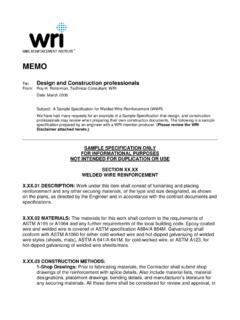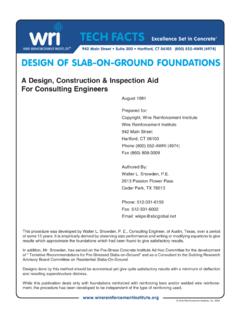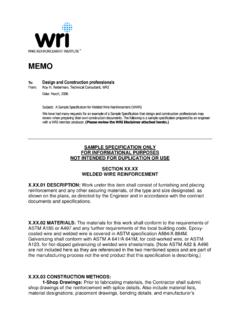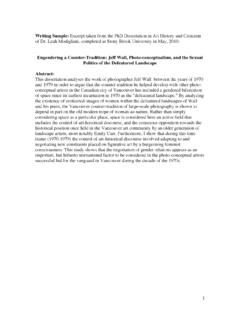Transcription of How to Specify, Order & Use Welded Wire …
1 TF 202-R-14. How to Specify, Order & Use Welded wire reinforcement In light construction Welded wire reinforcement (WWR). Widely Used Literally millions of square feet of residential slabs, driveways, sidewalks, patios and slabs for light construction are reinforced with Welded wire reinforcement (WWR). Welded wire reinforcement must be properly placed if it is to perform effectively. This publication will briefly discuss the reasons for using Welded wire reinforcement , its benefits and how to place it properly. WWR Used To Control Cracking Crack WWR reinforcement Concrete by its very nature tends to crack.
2 In residential and light construction , cracking is due primarily to drying shrinkage, temperature and moisture changes, weak subgrades and sometimes poor quality concrete. Steps can be taken to reduce cracking while other procedures control cracking. The primary purpose of Welded wire reinforcement in slabs is to control cracking and Reinforced Slab crack widths in both directions. Welded wire WWR holds slab closely together across crack so that cracked sections remain interlocked and the reinforcement keeps the cracked sections of a slab slab acts as a unit. This action is known as closely knit together so that the slab will act as a unit.
3 Aggregate interlock . WWR Helps Aggregate Interlock When a slab cracks, the faces within the crack are jagged. If the sections on each side of the crack are held closely together, the jagged faces of the concrete are interlocked which helps transfer loads across the crack. This factor is called aggregate interlock. As the crack becomes wider the interlock between the faces of the crack decreases and becomes less effective. In residential and light construction , aggregate interlock is usually ineffective when Unreinforced Slab the crack width exceeds 1/16 As a crack widens, aggregate interlock becomes less in.
4 ( ). Welded wire reinforcement holds the cracks effective. When cracks reach 1/16 inch or more in closely together so that aggregate interlock will function width, aggregate interlock is usually no longer properly. Closely knit cracks are also less noticeable, and effective. Wide cracks are also extremely noticeable. they minimize the movement of water through the slabs at cracks. Vertical Some Thoughts for Builders about Welded wire Displacement reinforcement Probably every builder has at one time or another said; If I. eliminate the Welded wire reinforcement , I'll save some money, or someone might have said, Take out the WWR.
5 And add another inch of concrete, it's cheaper. Someone else might have said, The stuff stays down on the bottom Vertical displacement is the difference in and doesn't do much good. Let's critically look at these elevation between two cracked sections of statements. a slab. It is one of s criteria on concrete slabs. Excellence Set in Concrete Page 1 wire reinforcement Institute, Inc. TF 202-R-14. Proper Placement is Essential Require fewer joints. The only practical way to control Welded wire reinforcement should be placed in the middle cracking in plain concrete is to use joints at very close one third of a 4 to 6 inch thick concrete slab or driveway.
6 Intervals generally less than 15ft. apart. Joints are WWR, partially buried in the subgrade, has little value. The acceptable in sidewalks and driveways. Joints are not reinforcement should be placed to reinforce the concrete, particularly desirable in floor slabs, porches, carports not the subgrade. When Welded wire reinforcement is and garages. Welded wire reinforcement reduces the properly placed, it does its job and does it well. need for many joints in these slabs. Thicker Slabs vs. reinforcement Table 1. This argument frequently arises but it overlooks three key * Provisions Home Owners Warranty Program points about cracking: on Cracking of Concrete Most cracks formed in residential and light construction Performance Standard are due to drying shrinkage and temperature changes.
7 Both four and five inch slabs will contract the same Maximum Maximum amount due to drying shrinkage, and will contract Permissible Permissible Crack Width Crack Width equally as the temperature drops. Thickening the slab does not change shrinkage and basement walls 1/8 . temperature contraction and reinforcement is still needed. Basement floors 3/16 *1/8 . The material cost of reinforcement is almost always less Attached garage slabs 1/4 1/4 . than the material cost of extra concrete. As a matter of fact, the in-place cost of Welded wire reinforcement may be Hairline only Stoops and steps.
8 Less than the material cost of an extra inch of concrete and (less 1/16 ). the WWR reinforces the entire slab. For example, the Patios 1/4 1/4 . material cost of an inch of concrete per square foot is $ when concrete reinforcement used is small. Any crack which significantly impairs appearance or performance of the Two widely used styles of reinforcement used in residential Slab-on-grade finish flooring material is not and light construction are 6x6 x (10 gauge) and acceptable. 6x6 x (6 gauge). These sheets of WWR only * Published by Home Owners Warranty Corporation, National Housing weigh lb and lb per square foot respectively.
9 We Center, Washington, 20005. suggest that you compare total costs. A reinforced slab may cost the same or less than a slightly thicker Proper Placement unreinforced slab and there is a difference. The proper placement of Welded wire reinforcement is relatively simple and inexpensive. There is no acceptable Some Additional Reasons to Use WWR reason for its improper placement. Welded wire The main purpose of reinforcement is crack control. Crack reinforcement should be placed in the middle third of 4 to 6. control is important in a residence. A home is generally a inch slabs.
10 Two inches below the surface is recommended family's largest investment and is a source of great pride. in most cases. Concrete slabs with cracks or uneven surfaces are a The most common ways of placing WWR are: matter of no little concern to homeowners. The proper (1) chairing WWR, placement of Welded wire reinforcement in slabs will go a (1) placing concrete in two courses and placing WWR. long way in reducing this concern. on the first course. WWR reinforcement will: Table 2. Improve performance of concrete work which means Proper Location of WWR in Slab higher owner satisfaction.














